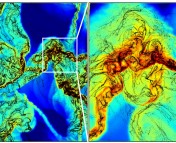Title: On the nature of variations in the measured star formation efficiency of molecular clouds
Authors: Michael Y. Grudic, Philip F. Hopkins, Eve J. Lee, Norman Murray, Claude-Andre Faucher-Giguere, and L. Clifton Johnson
First Author’s Institution: TAPIR, Mailcode 350-17, California Institute of Technology, Pasadena, CA 91125, USA
Status: Published in MNRAS; open access on arxiv
Takeaway: Observations of Giant Molecular Clouds (GMCs) yield large scatters in star formation efficiencies. Simulations in this work show that much of this scatter may stem from the fact we observe GMCs at different evolutionary stages driven by stellar feedback.
Stars are known to form within Giant Molecular Clouds (GMCs), huge complexes of gas and dust that range in mass from roughly one thousand to ten million times the mass of our sun. These regions are much denser than their surrounding environment, causing clumps of mass within them to collapse and form stars. However, this is actually a very complicated process with many compounding factors. One of the primary influences on the star formation process is stellar feedback, a broad category that refers to all the ways that existing stars affect their environment. This includes pressure from radiation emitted by stars, deposition of mass and energy from stellar winds and outflows, and supernova explosions. Today’s paper explores the way that stellar feedback affects the star formation process within GMCs over time.
It is very difficult to observationally quantify these effects, so astronomers measure the star formation efficiency (SFE) of GMCs to gain more understanding about the star formation process. SFE is defined as the total mass in stars within a GMC divided by the total mass of the GMC. In other words, it measures how much of the gas has been turned into stars. In the Milky Way, SFEs are observed to fall around ~1% with a significant scatter. Simulations used to severely overpredict SFEs, but modern simulations (including the ones in this work) with sophisticated treatments of stellar feedback have started to obtain SFEs close to the 1% level. This is because stellar feedback disperses and energizes the remaining gas, making it harder for it to continue collapsing and forming stars.
However, the larger scatter observed in SFEs of GMCs has remained a mystery. One would expect that two GMCs with similar initial mass, energy, and chemical composition should exhibit pretty similar SFEs, so some astronomers have dismissed this scatter as an observational bias due to imperfections in measurement techniques. The authors of today’s paper argue that this scatter is instead intrinsic to GMCs but varies over time; this means the scatter observed in SFEs is actually because the GMCs we observe are in different stages of their life.

To test this claim, the authors run simulations of GMCs with different masses and stellar feedback prescriptions. The time evolution of one of these GMCs is shown in Figure 1. In addition to finding that stellar feedback plays a big role in limiting SFE to the level of a few percent, they also find that GMCs go through different stages in their lives. First, a GMC forms with no stars, only gas and dust. As clumps of gas begin to collapse, the first stars form. After some time, the most massive of these stars begin to exert strong stellar feedback on their environment. This disrupts and energizes the surrounding gas, making it harder to form more stars. Eventually, the feedback is so strong the cloud is effectively blown apart, preventing any more stars from being formed. Consequently, the SFE of the cloud starts at 0, grows rapidly, and eventually plateaus due to stellar feedback. By simulating observations of the SFE at different times in the simulation, the authors show that the typical scatter in observed SFEs of real GMCs can be replicated (Figure 2).

The authors note that their simulations do not reproduce all observed properties of star formation in GMCs perfectly. In particular, SFEs in dense clumps of gas are higher in the simulations than in the observations, possibly indicating that the simulations need to include more physics in order to accurately model these dense regions. Nevertheless, identifying cloud evolution driven by stellar feedback as a possible reason for the large scatter observed in SFEs of GMCs represents a significant contribution to the intricate field of star formation. It is important to remember that even though the answers to these fundamental questions may be “written in the stars”, the story of star formation is still being actively composed.




